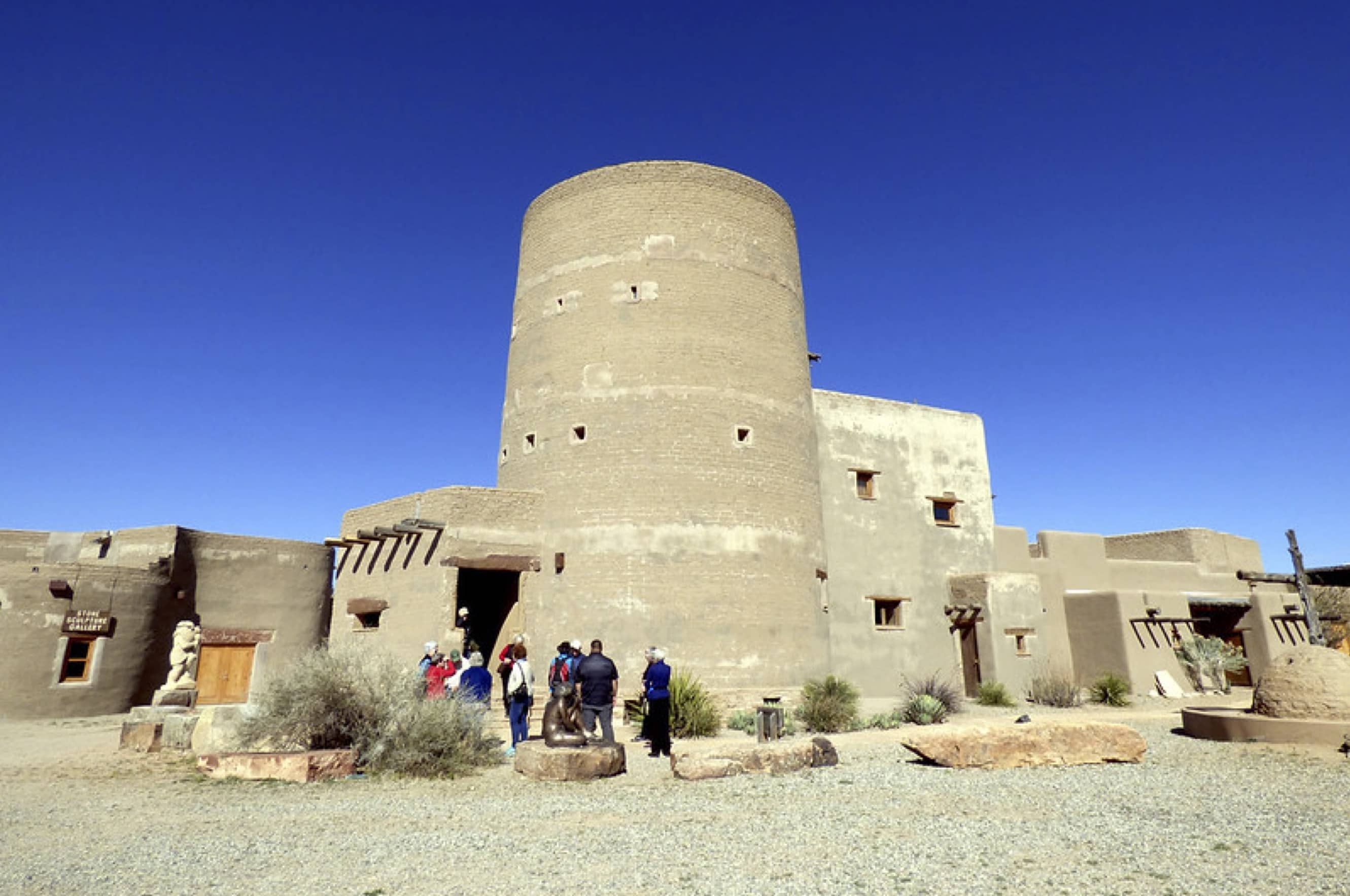
www.buildingsandcities.org/insights/commentaries/cop28-bridging-technical-cultural.html
COP28: Bridging Technical & Cultural Climate Solutions

Both technical advancements AND human- and nature-centred solutions of culture & heritage are needed.
Lori Ferriss (Architecture 2030) reflects on her attendance at COP28. Although COP28 included many wins for the built environment, it also marked a moment of missed opportunity to include valuable indigenous and heritage knowledge and culture-based climate solutions in the built environment agenda. Recommendations are made for improving policy pathways and the role of research.
Expectations for COP28
Ahead of COP28, expectations were high among many in the built environment community for focused climate commitments involving the building sector. Buildings contribute approximately 40% of global GHG emissions, consume roughly 40% of raw materials extracted from the earth (Valenti 2023), and generate 100 billion tonnes of waste annually, making them a central contributor to climate change and biodiversity loss. These statistics also make the sector a rich source of climate solutions, from improving energy efficiency through retrofits and building performance standards, to creating a circular economy that minimizes the need for new materials, and drawing down and storing carbon in bio-based construction materials. Through collaboration with forestry and agriculture, buildings are poised to become a player in cross-sectoral transformation.
Importantly, though less discussed, is the immense climate action potential within the existing built environment as a physical manifestation of socio-cultural and indigenous knowledge. Old structures hold information about how buildings were constructed and lived in before easy access to fossil fuel energy and subsequent industrialisation of the sector. Historical building practices relied on locally extracted, low-carbon and repairable materials, as well as passive performance and thermal comfort features e.g. thermal chimneys and high-mass walls. Particularly in the Global South, this knowledge of sustainable and resilient construction methods is still used by necessity and is a central mechanism for intergenerational cultural preservation (Mandillah & Ekosse 2018; Widodo 2012). Thus, the built environment is uniquely positioned to accelerate climate positive outcomes because it unites both technical and cultural solutions.
Promoting building reuse and carbon storing materials
The UN's scientific reports focus on embodied carbon of building materials, reuse and retrofit, and carbon storing natural materials as critical solutions. These concepts are evidenced in reports like the 'Building Materials and the Climate: Constructing a New Future' (UNEP and Yale Center for Ecosystems + Architecture 2023) and the 2022 Global Status Report for Buildings and Construction (UNEP 2022) and the 'Buildings' chapter of the IPCC Sixth Assessment Report (Cabeza et al. 2022) and are emerging as central climate action strategies in scientific thinking at the highest levels.
Built environment milestones at COP28
COP28's Built Environment Day marked another landmark for the building sector as the governments of France and Morocco, together with the UN Environment Programme (UNEP), launched the Buildings Breakthrough (UNEP 2023).The Buildings Breakthrough formally brings the built environment into the Breakthrough Agenda, a programme initiated at COP26 to 'close the collaboration gap and accelerate international action'. Twenty-seven countries, representing about half of global GHG emissions, committed taking coordinated action to make near-zero-emission and resilient buildings the norm by 2030. The first buildings-focused Ministerial Meeting (in Paris in March 2024) will advance implementation of the Breakthrough, which will include an annual assessment of global progress in the sector aligned with the existing UNEP/GlobalABC annual Global Status Report for Buildings and Construction. COP28 was also the venue for the second multilateral Ministerial Meeting on Urbanization and Climate Change, in which nation states shared their progress and commitment to climate action in their built environments.
However, rather than focusing on the strategies of reuse, circular economy, and natural materials identified by UNEP and the Global ABC and echoed by industry, much airtime at COP28 was dedicated to incremental improvements to business as usual. This included setting targets to reduce emissions from concrete and cement rather than avoiding its use in in the first place or replacing it with bio-materials. What is actually needed are new building codes that learn from the culturally specific, place-based solutions (and avoid the Global North's existing industrial approaches). These alternative solutions already exist and could indeed inform mainstream industrial practices.
Resilience was also largely missing from the Building Breakthrough conversations, despite its central role in the very definition of the Breakthrough, as were the impacts on the human beings who will live and workin the built environment. Sufficiency - the concept promoted by the IPCC of right-sizing how much building we need to begin with - was only minimally addressed.
At a global policy level, the conversation around unifying building sector climate action is nascent, focused on a long overdue consensus on the need for near zero emissions buildings, common definitions and frameworks for sustainable and resilient buildings, and commitments to work toward common decarbonization goals.
The missing link: cultural heritage and indigenous knowledge
Apart from official buildings and cities events at COP28, the first Ministerial Meeting on Culture and Climate was held by the newly established Group of Friends of Culture-Based Climate Action, including ministers and leaders from over 30 countries. While culture is acknowledged as an enabler of climate transformation, UN agreements have primarily focused ontechnical solutions, neglecting the many opportunities associated with arts, culture, and heritage. The Group of Friends marks the beginning of an official process to incorporate social-cultural solutions into UN climate frameworks and commitments over the next several years.
Across the COP, stories were shared of real impact toward climate mitigation, adaptation, and capacity building from cultural heritage practitioners and ancestral knowledge keepers around the world. As Johannes Widodo of the National University of Singapore and Climate Heritage Network said:
When we prioritize cultural wisdom, human centered design, and common sense over advanced technologies, designing a sustainable, energy-positive contemporary architecture can be achieved in reality.
Communities showcased the principles of circular economy, carbon storing materials, and sufficiency through their own lenses and with their own language. There were sessions demonstrating indigenous approaches to capacity-building for climate resilience, use of traditional, low-carbon building methods to promote gender equity on construction sites, and the value of culture to communicate and inspire climate action.
Sadly, these 'grassroots' solutions were not visibly present on stage at the Buildings Breakthrough, nor were they major contributors to programming in the Buildings Pavilion, the official space of the Global ABC.
Gaps in strategy
There is a chasm between the official commitments and strategies shared at COP28 and the real work being done to enact these strategies and others across the globe. Likewise, there is a gap between the largely Global North industrialised and commercialised stakeholders participating in the Buildings Breakthrough initiatives and the indigenous communities and cultural sector who are implementing unrecognized climate action now.
When the Global South is discussed in the buildings space, these regions tend to be treated as recipients of technological and financial aid, not as knowledge holders or empowered resources with real solutions to offer. Many of these communities are the keepers of wisdom and practitioners of sufficiency, circular economy, and low-carbon technologies (although perhaps not using this vocabulary). This makes them important partners in climate action. When an all-of-society response is needed, valuable knowledge is passed over by not including indigenous, heritage, and traditional knowledge holders in the official Building Breakthrough agenda and UN frameworks.
Advancing coordinated climate action
COP28 was the first step of both the Buildings Breakthrough and theGlobal Friends of Culture-Based Climate Action, each begun without intentional cross-alignment. Continued advocacy and radical collaboration are clearly needed to bridge the divide between the valuable existing knowledge and solutions (involving existing and historic buildings, culture, local knowledge and nature-based solutions) and the formal climate commitments of the COPs and national and sub-national policy.
A key step in 2024 will be to include the built environment as a manifestation of culture as a key climate action lever within the Global Friends of Culture-Based Climate Action. The built environment is one mechanism to tie culture-based actions into existing climate frameworks and policies, particularly at national and sub-national levels.
Similarly, lessons from heritage and existing buildings must be incorporated across all priority areas of the Buildings Breakthrough, beginning with the thematic session on heritage buildings at the Global Forum in Paris, co-led by Architecture 2030 and the Climate Heritage Network and support by many international organizations. To name a few pathways, policies must be developed that incentivise an increased rate of responsible retrofits to achieve a resilient and decarbonised built environment, particularly in developed areas. Codes and standards must offer flexibility to leverage indigenous knowledge of place-based, climate friendly building practices, particularly in rapidly developing areas where the world cannot afford the embodied carbon footprint of replicating Global North approaches.
The research community can expand the dissemination of knowledge of indigenous and traditional building knowledge. Research can demonstrate how heritage building methods and the new technologies required to preserve old buildings can be rapidly scaled up.
It is evident from climate science that the planet is reaching a tipping point that can only be averted with a unified and immediate response. Both the technical advancements and industry alignment demonstrated with the Building Breakthrough AND the immediately deployable, human- and nature-centered solutions of culture and heritage are needed - the built environment cannot afford to leave behind people or knowledge in service of a more resilient, just, and beautiful future.
References
Cabeza, L. F., Bai, Q., Bertoldi, P., Kihila, J.M., Lucena, A.F.P., Mata, É., Mirasgedis, S., Novikova, A. & Saheb, Y. (2022). Buildings. In: Climate Change 2022: Mitigation of Climate Change. Contribution of Working Group III to the Sixth Assessment Report of the Intergovernmental Panel on Climate Change [P.R. Shukla, J. Skea, R. Slade, A. Al Khourdajie, R. van Diemen, D. McCollum, M. Pathak, S. Some, P. Vyas, R. Fradera, M. Belkacemi, A. Hasija, G. Lisboa, S. Luz, J. Malley, (eds.)]. Cambridge, UK: Cambridge University Press. https://doi.org/10.1017/9781009157926.011
Mandillah, K. L. & Ekosse, G.I. (2018). African totems: cultural heritage for sustainable environmental conservation. Conservation Science in Cultural Heritage, 18(1),201-18. https://doi.org/10.6092/issn.1973-9494/9235
UNEP. (2022). 2022 Global Status Report for Buildings and Construction: Towards a Zero‑emission, Efficient and Resilient Buildings and Construction Sector. Nairobi: United Nations Environment Programme. ISBN: 978-92-807-3984-8. https://globalabc.org/sites/default/files/2023-03/2022%20Global%20Status%20Report%20for%20Buildings%20and%20Construction_1.pdf
UNEP. (2023, December 6). The buildings breakthrough: global push for near-zero emission and resilient buildings by 2030. UN Environment Programme. https://www.unep.org/news-and-stories/press-release/buildings-breakthrough-global-push-near-zero-emission-and-resilient
UNEP & Yale Center for Ecosystems + Architecture. (2023). Building Materials and the Climate: Constructing a New Future. Nairobi: United National Environmental Programme. ISBN: 978-92-807-4064-6. https://wedocs.unep.org/20.500.11822/43293
Valenti, L. (2023). Sustainable sourcing of raw materials for the built environment. Materials Today: Proceedings. https://doi.org/10.1016/j.matpr.2023.07.308
Widodo, J. (2012). Urban environment and human behaviour: learning from history and local wisdom. Procedia, Social and Behavioral Sciences, 42, 6-11. https://doi.org/10.1016/j.sbspro.2012.04.161
Latest Peer-Reviewed Journal Content
Acceptability of sufficiency consumption policies by Finnish households
E Nuorivaara & S Ahvenharju
Key factors for revitalising heritage buildings through adaptive reuse
É Savoie, J P Sapinski & A-M Laroche
Cooler streets for a cycleable city: assessing policy alignment
C Tang & J Bush
Understanding the embodied carbon credentials of modern methods of construction
R O'Hegarty, A McCarthy, J O'Hagan, T Thanapornpakornsin, S Raffoul & O Kinnane
The changing typology of urban apartment buildings in Aurinkolahti
S Meriläinen & A Tervo
Embodied climate impacts in urban development: a neighbourhood case study
S Sjökvist, N Francart, M Balouktsi & H Birgisdottir
Environmental effects of urban wind energy harvesting: a review
I Tsionas, M laguno-Munitxa & A Stephan
Office environment and employee differences by company health management certification
S Arata, M Sugiuchi, T Ikaga, Y Shiraishi, T Hayashi, S Ando & S Kawakubo
Spatiotemporal evaluation of embodied carbon in urban residential development
I Talvitie, A Amiri & S Junnila
Energy sufficiency in buildings and cities: current research, future directions [editorial]
M Sahakian, T Fawcett & S Darby
Sufficiency, consumption patterns and limits: a survey of French households
J Bouillet & C Grandclément
Health inequalities and indoor environments: research challenges and priorities [editorial]
M Ucci & A Mavrogianni
Operationalising energy sufficiency for low-carbon built environments in urbanising India
A B Lall & G Sethi
Promoting practices of sufficiency: reprogramming resource-intensive material arrangements
T H Christensen, L K Aagaard, A K Juvik, C Samson & K Gram-Hanssen
Culture change in the UK construction industry: an anthropological perspective
I Tellam
Are people willing to share living space? Household preferences in Finland
E Ruokamo, E Kylkilahti, M Lettenmeier & A Toppinen
Towards urban LCA: examining densification alternatives for a residential neighbourhood
M Moisio, E Salmio, T Kaasalainen, S Huuhka, A Räsänen, J Lahdensivu, M Leppänen & P Kuula
A population-level framework to estimate unequal exposure to indoor heat and air pollution
R Cole, C H Simpson, L Ferguson, P Symonds, J Taylor, C Heaviside, P Murage, H L Macintyre, S Hajat, A Mavrogianni & M Davies
Finnish glazed balconies: residents' experience, wellbeing and use
L Jegard, R Castaño-Rosa, S Kilpeläinen & S Pelsmakers
Modelling Nigerian residential dwellings: bottom-up approach and scenario analysis
C C Nwagwu, S Akin & E G Hertwich
Mapping municipal land policies: applications of flexible zoning for densification
V Götze, J-D Gerber & M Jehling
Energy sufficiency and recognition justice: a study of household consumption
A Guilbert
Linking housing, socio-demographic, environmental and mental health data at scale
P Symonds, C H Simpson, G Petrou, L Ferguson, A Mavrogianni & M Davies
Measuring health inequities due to housing characteristics
K Govertsen & M Kane
Provide or prevent? Exploring sufficiency imaginaries within Danish systems of provision
L K Aagaard & T H Christensen
Imagining sufficiency through collective changes as satisfiers
O Moynat & M Sahakian
US urban land-use reform: a strategy for energy sufficiency
Z M Subin, J Lombardi, R Muralidharan, J Korn, J Malik, T Pullen, M Wei & T Hong
Mapping supply chains for energy retrofit
F Wade & Y Han
Operationalising building-related energy sufficiency measures in SMEs
I Fouiteh, J D Cabrera Santelices, A Susini & M K Patel
Promoting neighbourhood sharing: infrastructures of convenience and community
A Huber, H Heinrichs & M Jaeger-Erben
New insights into thermal comfort sufficiency in dwellings
G van Moeseke, D de Grave, A Anciaux, J Sobczak & G Wallenborn
'Rightsize': a housing design game for spatial and energy sufficiency
P Graham, P Nourian, E Warwick & M Gath-Morad
Implementing housing policies for a sufficient lifestyle
M Bagheri, L Roth, L Siebke, C Rohde & H-J Linke
The jobs of climate adaptation
T Denham, L Rickards & O Ajulo
Structural barriers to sufficiency: the contribution of research on elites
M Koch, K Emilsson, J Lee & H Johansson
Disrupting the imaginaries of urban action to deliver just adaptation [editorial]
V Castán-Broto, M Olazabal & G Ziervogel
Nature for resilience reconfigured: global- to-local translation of frames in Africa
K Rochell, H Bulkeley & H Runhaar
How hegemonic discourses of sustainability influence urban climate action
V Castán Broto, L Westman & P Huang
Fabric first: is it still the right approach?
N Eyre, T Fawcett, M Topouzi, G Killip, T Oreszczyn, K Jenkinson & J Rosenow
Social value of the built environment [editorial]
F Samuel & K Watson
Understanding demolition [editorial]
S Huuhka
Data politics in the built environment [editorial]
A Karvonen & T Hargreaves



Latest Commentaries
Decolonising Cities: The Role of Street Naming
During colonialisation, street names were drawn from historical and societal contexts of the colonisers. Street nomenclature deployed by colonial administrators has a role in legitimising historical narratives and decentring local languages, cultures and heritage. Buyana Kareem examines street renaming as an important element of decolonisation.
Integrating Nature into Cities
Increasing vegetation and green and blue spaces in cities can support both climate change mitigation and adaptation goals, while also enhancing biodiversity and ecological health. Maibritt Pedersen Zari (Auckland University of Technology) explains why nature-based solutions (NbS) must be a vital part of urban planning and design.